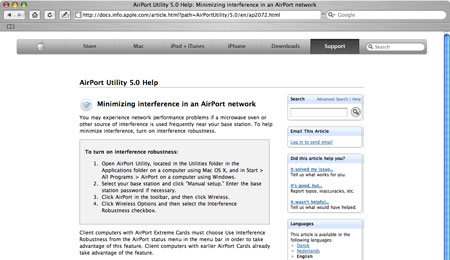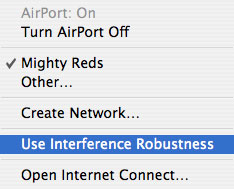What is Interference Robustness?
Arbi Karamians September 10, 2007 Tutorials Mac Network
Few topics have ever been more exhaustively analyzed and discussed within Internet/Macintosh based forums than the Apple AirPort feature “Interference Robustness.” The lack of information made available by Apple regarding the feature makes for a lot of confused and curious Mac users. Unfortunately the aforementioned forums appear to be the only venue through which one can find any significant information regarding Interference Robustness. In fact, I ran a quick search on “Mac Help” on my MacBook Pro and within all the documentation provided by Apple, Interference Robustness was mentioned on a single occasion. And that reference was limited to “If you are using an AirPort Extreme wireless card and are experiencing network interference, you can use the status menu to turn on Interference Robustness.” Simple enough, but several questions remain: “What does it do and how does it work? When should I use it? If it cuts down on interference shouldn’t I leave it on all the time?”

These specific questions appear to be the most common topic of discussion online, and they’re specific questions that have been left unanswered. Whether it’s by design (for one Steve Jobs reason or another) or simply that they believe it’s self-explanatory, the fact remains that Interference Robustness is the Area 51 of OS X. I know it seems a bit cheeky to compare an OS X feature to a highly secure government compound which is said to host the development and testing of military aircraft, but seriously, try for yourself - Google it. After some serious scouring, I honestly believe you’d be more successful obtaining information regarding the goings on at the Groom Lake compound.

So after I’d received no sound explanation from “Mac Help,” I went one step further and ran a similar search on the Apple website and was actually surprised to find zero results on the topic. I then moved on to the Apple Support page and ran a similar query that provided me with 17 matches. The majority of the results provided instructions on how to enable the feature through your AirPort and AirPort Extreme. What they did not provide were answers to the questions people have been asking.
So what the heck is it?
In order to move forward and tackle these questions and uncover the inner workings of Interference Robustness, we first need to cover some of the basics of Wireless Local Access Networks (WLAN.) Basic home networks utilize the 802.11 standard (Wi-Fi) developed by the Institute of Electrical and Electronics Engineers (IEEE.) To the best of my knowledge, all home networking hardware utilizes this standard. Different variations of the 802.11 standard exist, beginning with 802.11a and adding modulation ratifications of 802.11b, g, and the most recent n.
Each new modulation standard resolved issues from previous versions while also increasing range and data rate. For instance, the indoor range for 802.11a is roughly 35 meters while the range for 802.11n is roughly 70 meters. I’m sure all of you can imagine how one would benefit from using a router that supported 802.11n in your home or home/office.
The amendments to the standards changed a lot of things but what they didn’t change was the operating frequency. They operate under a 2.4-2.5 Ghz band. This is troublesome simply because most home appliances operate in the same band. For instance most home cordless phones, microwave ovens and most Bluetooth devices have an op. frequency of 2,4Ghz. So one can see how each connection may face interference.

Most wireless hardware manufacturers have already taken preemptive measures to battle interference from other sources. Interference Robustness is Apple AirPort’s insurance policy against interference caused by outside variables. It’s also important to understand that if you run a Mac and use a Linksys, Netgear, Belkin or one of the many other options one has, checking the “Use Interference Robustness” option will not work. Interference Robustness is specific to Macs connected to Apple’s AirPort Express and Airport Extreme. So with all that having been said let’s answer some questions.
What does it do? How does it work?
The 802.11 protocol was designed to essentially adjust itself to protect itself from interference. More specifically it adjusts packet size. The idea is this: send smaller packets at higher speeds, and the access point will more securely receive the packets. So when faced with interference, this option will literally adjust the transmission of packets to ensure the access point receives more packets.
When should I use it?
It really depends on the situation. Some users will experience WLAN issues based on the specific products they have in their home in this case use Interference Robustness. Others will face WLAN issues because they either live or work in a highly populated area such as an apartment building or office building. This would be an ideal time to use Interference Robustness. Basically, whenever you face WLAN interference that is caused by outside variables, Interference Robustness will help.
If it cuts down on interference, shouldn’t I leave it on all the time?
No. This is very important to understand. Using Interference Robustness will essentially slow down your wireless connection. As discussed above, if you’re looking for speed, you send a high frequency of large packets. If you’re looking to battle interference you send smaller packets at a lower frequency. So your connection will be slow but strong.

I hope this helps you better understand why it’s there and why it’s necessary – for some more importantly how it works!
Subscribe to our email newsletter
Sign up and get Macinstruct's tutorials delivered to your inbox. No spam, promise!